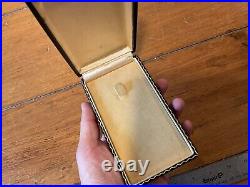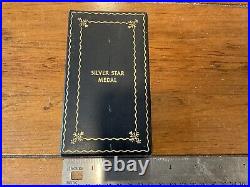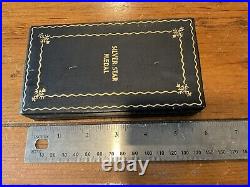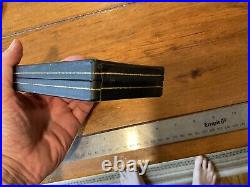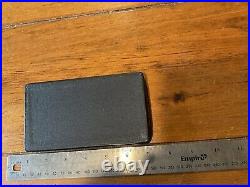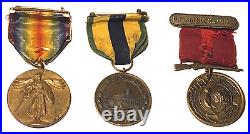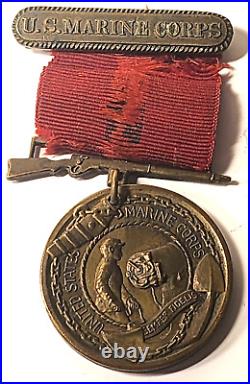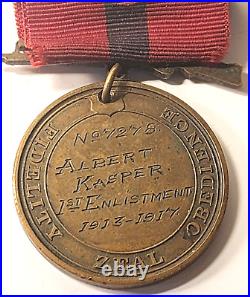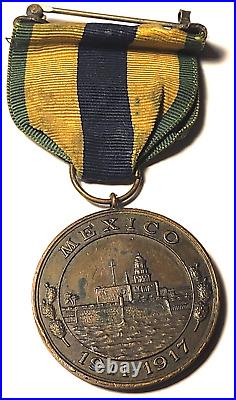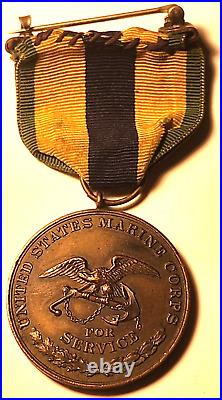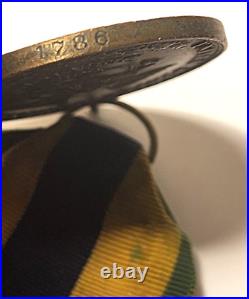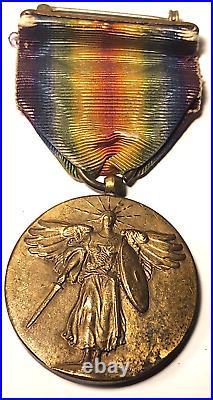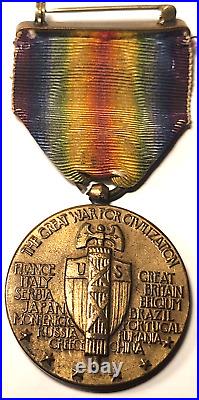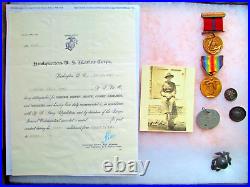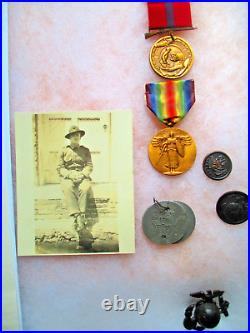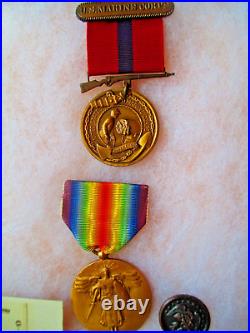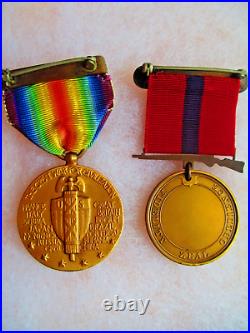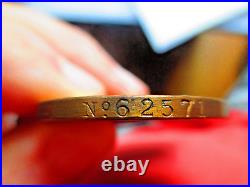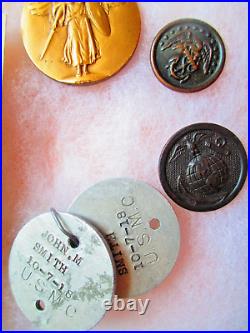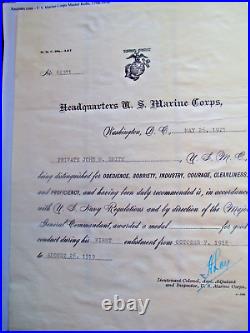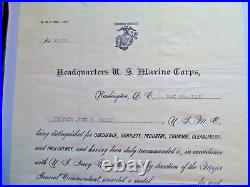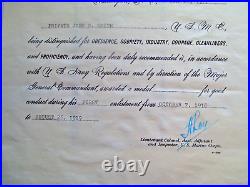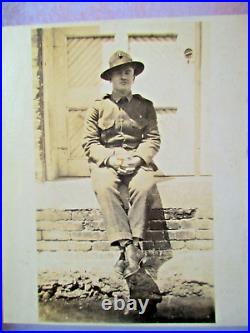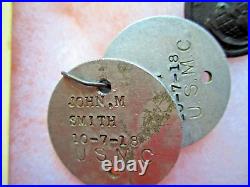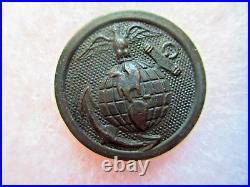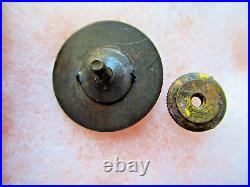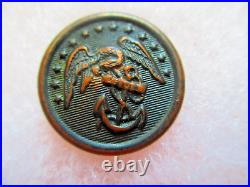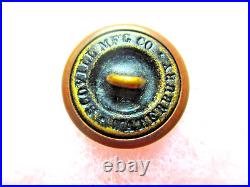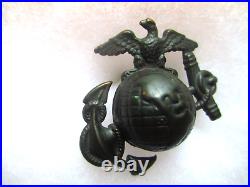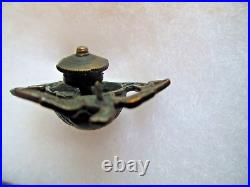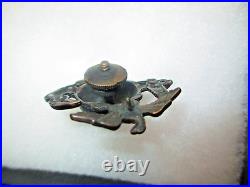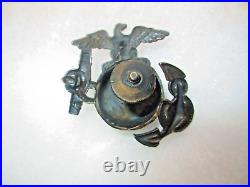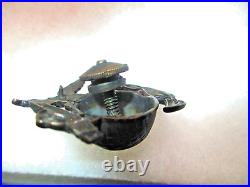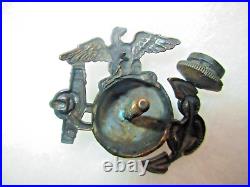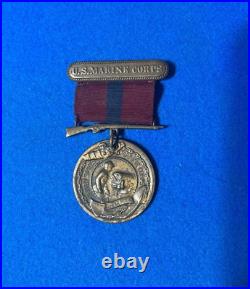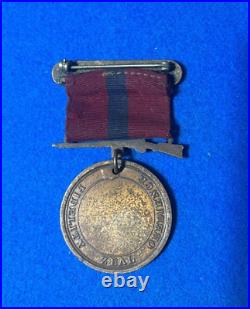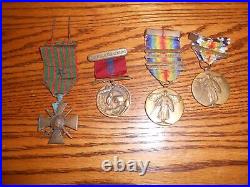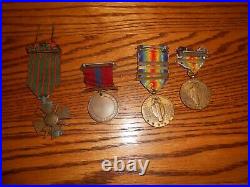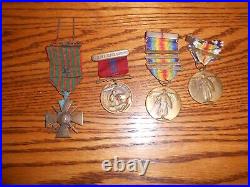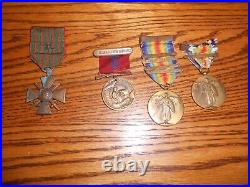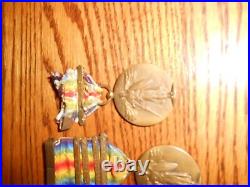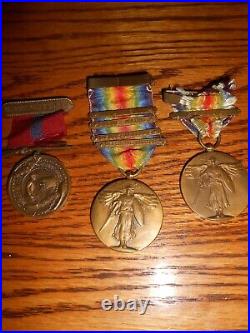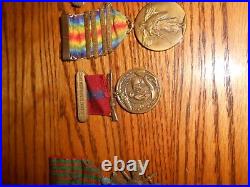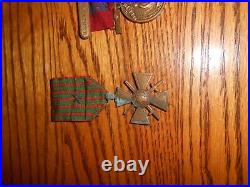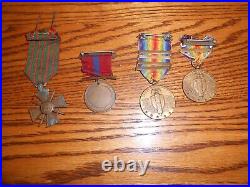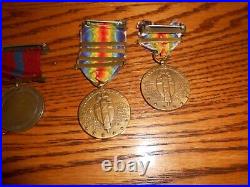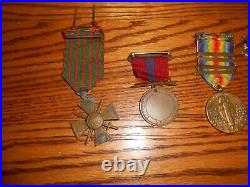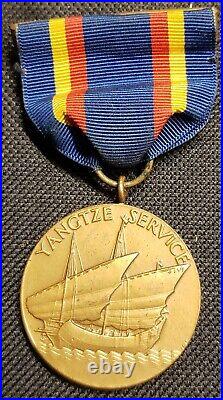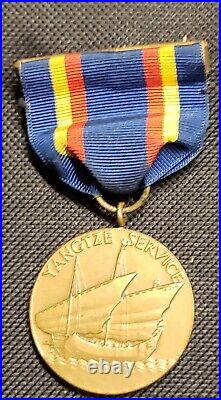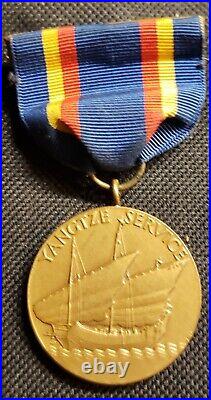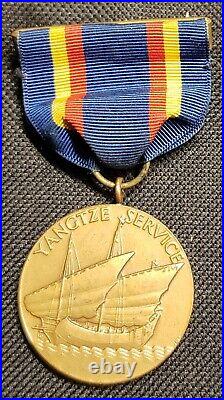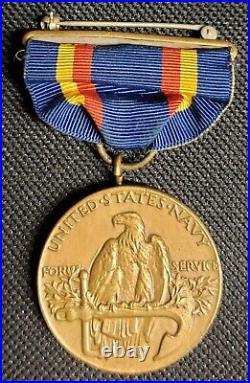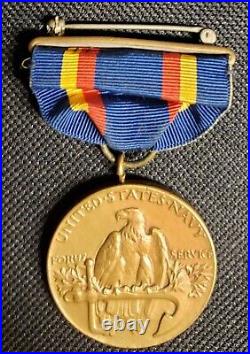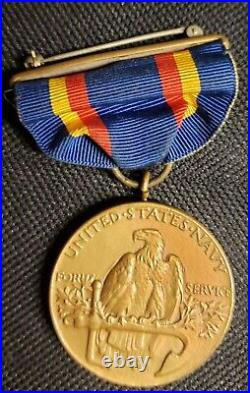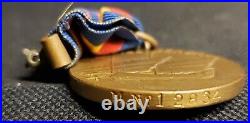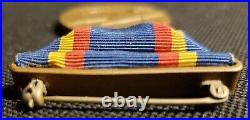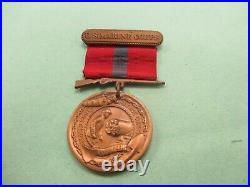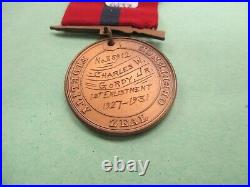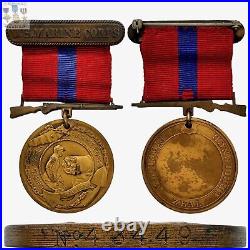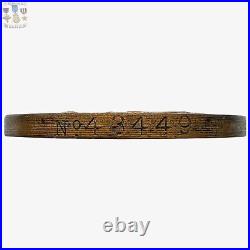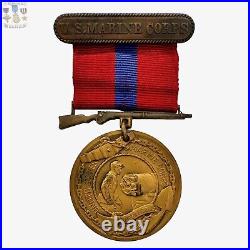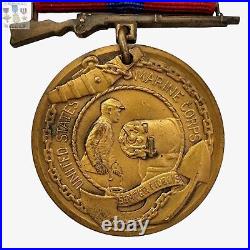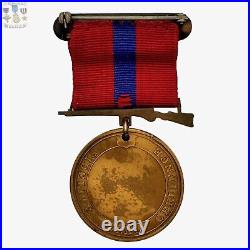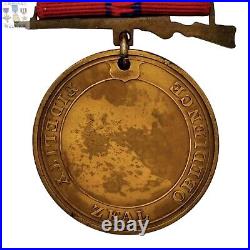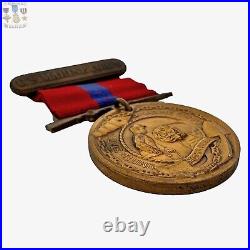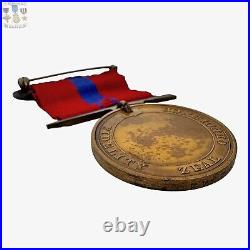Posts tagged usmc
Here’s a nice Goodwill find. A WW2 USMC medal grouping that belonged to a Gilbert M. His name is engraved on the back of the Marine Good Conduct Medal. Included in this grouping are the following: USMC Good Conduct Medal, American Campaign Medal, World War ll Medal, Armed Forces Reserve Medal, National Defense Medal, Asiatic Pacific Campaign Medal, Joint Meritorious Medal, Expert Rifleman Badge, Enlisted Aircrew Wings, and 4th Marine Air Wing Patch. The medals are in good condition, have a nice patina, and you can tell these were actually worn on a service members uniform. The grouping is housed in a picture frame measuring approximately 10 3/4″ x 8 3/4″. There is some wear, dings, and scuff marks on the picture frame. This is a nice grouping that would make a great addition to your USMC collection. The posted photographs are an important part of the physical description. Closely view all of them, so you may judge for yourself the condition, quality, and age of the items.
Part of SgtMaj Sywanyks estate collection of rare USMC collectables. WW1 City of Norfolk medal presented to Historical figure General Lemuel Shepherd Commandant Marine Corps. Medal is tarnished and ribbon is torn. Lemuel Cornick Shepherd Jr. (February 10, 1896 – August 6, 1990) was a General. In the United States Marine Corps. 20th Commandant of the Marine Corps. Recipient, veteran of World War I. And the Korean War. As Commandant, he secured a place on the Joint Chiefs of Staff. Gaining parity for the Marine Corps with the other military services. Early life and education. Was born February 10, 1896, in Norfolk, Virginia. He graduated from the Virginia Military Institute. Graduating a year early so he could enter the Marine Corps. While at VMI, Shepherd became a member of the Beta Commission of Kappa Alpha Order. He was commissioned a second lieutenant. In the Marine Corps on April 11, 1917, five days after the American entry into World War I. And reported for active duty at the Marine Barracks, Port Royal, South Carolina. On May 19, 1917. Less than a month after reporting for duty, Shepherd sailed for France on June 17, 1917, as a member of the 5th Marine Regiment. With the first elements of the American Expeditionary Forces. (Army and Marine Corps troops), and arrived at Saint-Nazaire. In western France on June 27. The 5th Marines became part of the 4th Marine Brigade. 2nd Division 2nd Infantry Division. , when the division was organized on October 26 in France. The 2nd Division was placed under the command of Marine Corps Brigadier General. Who had been the 5th Marines commander. The 2nd Division trained with French Army veterans the winter of 1917-18. Shepherd served in defensive sectors in the vicinity of Verdun. When the American Expeditionary Forces (AEF) was committed to combat in the spring of 1918 to halt a German advance towards Paris. He participated in the Aisne-Marne offensive. Where he was twice wounded in action at Belleau Wood. During the fighting there in June 1918. On July 28, 1918, Marine Corps Major General John A. Marine Corps Base Camp Lejeune. Named 1942 assumed command of the 2nd Division. Where he was wounded for the third time, shot through the neck by a machine gun. For his gallantry in action at Belleau Wood. Lieutenant Shepherd was awarded the Army. And the Navy Cross. The French Croix de guerre. And was cited twice in the general orders of the 2nd Infantry Division. He also received the Montenegrin Silver Medal for Bravery. After duty with the Army of Occupation. Shepherd sailed for home in July 1919. His assignment was to prepare relief maps showing the battlefields over which the 4th Marine Brigade 5th and 6th Marines. And 6th Machine Gun Battalion. 2nd Infantry Division, had fought. Aide and aide-de-camp to the commandant of the Marine Corps, Major General John A. In July 1922, he took command of a selected company of Marines at the Brazil’s Centennial Exposition. In Rio de Janeiro. In June 1923, Shepherd was ordered to sea duty as commanding officer of the Marine Detachment. On the USS Idaho (BB-42). This tour was followed by duty at the Marine Barracks, Norfolk, where he commanded the Sea School. In April 1927, Shepherd sailed for expeditionary duty in China, where he served in the 3rd Marine Brigade. After graduation Captain Shepherd was assigned overseas again, this time on detached duty with the Garde d’Haïti. Serving for four years as a district and department commander in the United States occupation of Haiti. Following the withdrawal of Marines from Haiti in 1934, Shepherd was detailed to the Marine Barracks, Washington, D. As executive officer and as registrar of the Marine Corps Institute. Following graduation in May 1937 from the Naval War College. At Newport, Rhode Island. Shepherd commanded the 2nd Battalion, 5th Marine Regiment. Part of the newly formed Fleet Marine Force. (FMF), Atlantic, which was being extensively employed in the development of amphibious tactics and techniques. In June 1939, Shepherd was ordered to the Staff of Marine Corps Schools. Where he served during the next three years as director, Correspondence School; chief of the Tactical Section; officer in charge of the Candidates Class; and assistant commandant. In March 1942, four months after the United States entry into World War II, Colonel. Shepherd took command of the 9th Marine Regiment. He organized, trained, and took the unit overseas as part of the 3rd Marine Division. Upon promotion to brigadier general. In July 1943, Shepherd served on Guadalcanal. Shepherd was assigned as assistant division commander of the 1st Marine Division. In this capacity, he participated in the Cape Gloucester. Operation on New Britain. From December 1943 through March 1944, where he was awarded a Legion of Merit. For exceptionally meritorious service. In command of operations in the Borgen Bay area. In May 1944, Shepherd assumed command of the 1st Provisional Marine Brigade and led them in the invasion and subsequent recapture of Guam. During July and August 1944. For distinguished leadership in this operation, Shepherd received his first Distinguished Service Medal. And was promoted to major general. After organizing the 6th Marine Division. From the brigade, Shepherd commanded it throughout the Battle of Okinawa. Where, for exceptionally meritorious service as commanding general of the 6th Marine Division in the assault and occupation of Okinawa (April 1 to June 21, 1945) he was awarded a Gold Star in lieu of a second Distinguished Service Medal. Subsequently, he took the division to Tsingtao. There, October 25, 1945, he received the surrender of the Japanese forces in this area for which he was awarded a second Legion of Merit. At NAB Little Creek. On October 17, 1946, Shepherd assumed the post of Assistant Commandant of the Marine Corps. He remained at this post until April 1948, when he was assigned to Quantico. Where he served as commandant of the Marine Corps Schools until June 1950. When the Korean War. Erupted, Shepherd was in command of the Fleet Marine Force (FMF), Pacific, with headquarters at Pearl Harbor. In this capacity, he played a major role in the amphibious assault at Inchon. Earning a Silver Star. And in the evacuation of U. Following their withdrawal from the Chosin Reservoir. In Korea he saw the usefulness and advantages of Helicopters on the frontlines and was amongst those pushing for the increase in number of helicopters in the armed forces saying No effort should be spared to get helicopters… To the theater at once – and on a priority higher than any other weapon. On January 1, 1952, President Harry S. Appointed Shepherd Commandant of the Marine Corps. During Shepherd’s four years as commandant, he initiated a number of important policies that resulted in increased military proficiency for the Marine Corps, one of the first and widest reaching of which was the institution of a General Staff System. Shepherd presented the Marine Corps War Memorial. To the American people at the dedication of the memorial on November 10, 1954, the 179th anniversary of the founding of the Marine Corps. He was the first commandant to become a member of the Joint Chiefs of Staff. And upon his retirement on January 1, 1956, he was awarded a third Distinguished Service Medal. Two months after his retirement, Shepherd was recalled to active duty and appointed chairman of the Inter-American Defense Board. During his three and a half years of service with this international organization, Shepherd, through his leadership and diplomacy, made substantial contributions towards plans for the defense of the continent. He also promoted military solidarity among the military forces of the republics of the Western Hemisphere. Shepherd died at age 94 from bone cancer. At his home in La Jolla, California.
These medals have some wear from normal use. The ribbon on the Good Conduct Medal is frayed. It is numbered NO. The Mexico Service Medal is numbered 1786 on the rim. (See photos for details) Additional photos available upon request. Please specify details you would like to see more clearly. Most items not sent internationally.
Up for sale we have a lot of 4 WW1 medals. The 4 bar WW1 Victory medal is in very nice shape. WW1 USMC good conduct medal is in nice shape but ribbon is fraying at bottom where it meet medal. Second WW1 Victory medal ribbon is rough but bar and medal are nice. The Croix De Guerre has some tarnishing on bronze. If you need more information just ask.
ORIGINAL WORLD WAR I UNITED STATES MARINE CORPS GOOD CONDUCT MEDAL, SEWN BAR BROOCH. RIBBON DRAPE TESTED U. The Marine Corps Good Conduct Medal was established on 20 July 1896. The medal was originally a ribbon and medal suspended from a clasp bearing the words U. The clasp was eliminated after WWII and the medal has remained unchanged in appearance since that time. Since its inception in 1896, the name of the recipient was engraved by hand on the reverse side of the medal until stamping the name on the medal began during World War II (numbered on the rim) and was done completely by 1951. In 1953, the Marine Corps adopted bronze and silver 3/16-inch service stars to denote additional awards of the Good Conduct Medal, replacing enlistment bars showing each honorable period of service. Since 10 December 1954, members of the Marine Corps must have three consecutive years of honorable and faithful service in order to be eligible for the medal. The Marine Corps Good Conduct Medal is affectionately nicknamed, “The Good Cookie” by Marines. Please let me know if there’s anything else I can do for you!








